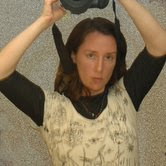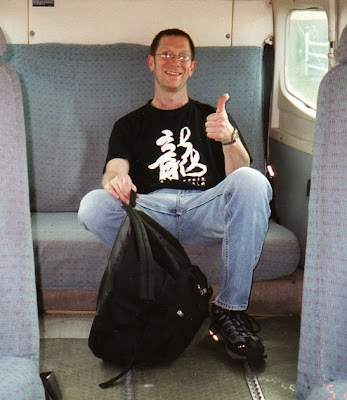
In this interview, I talk to multi-talented
Nancy J. Parisi about photography, her annual Red Dinner and her positively radiant personality!
(photo at right: Self Portrait by Nancy J. Parisi)
You make your living as a commercial photographer and you also make photographs as your art. Do you approach the commercial work in a different way than your artwork?I approach both my commercial and art work in the same way, with a sense of discovery and openness to possibility, you should never presuppose that you have all the answers to a situation. You’re carrying into any portrait/event/art situation a set of tools and knowledge, but there might be something in the room that can be used as a prop, or something there that’s unexpected. I balance knowledge with curiosity, a goal with chance.
How do you balance the two?That’s the great challenge of my world, trying to balance being a commercial photographer and artist. I usually find that artwork is last on my list. I get to a point when I know I must make some artmaking time, without that I can get very frustrated. A lot of what I do is documenting the accomplishments of others, that’s a talent that I have, but I have to remind myself sometimes that I’m an artist too.
How did you get your start in photography?I fell in love with photography when I was very young, at seven years old. I would make photographs with my father’s camera, until I received my own camera. When I was a young teenager I took a photography class with an artist at a neighborhood community center with a neighbor who was also interested in photography. My friend had a great interest, and not that much passion for the craft. Later, when I was 17 and entering University at Buffalo, that artist was teaching a couple of classes at UB and encouraged me to continue with it, and I did. It was her prompting that got me going – I thanked her years later for her encouragement. I borrowed my neighbor’s father’s old 35mm rangefinder, a beauty, a Zeiss from the 40s. After that I worked to save my money to buy my first 35mm camera, a sturdy and dependable (and inexpensive) Pentax K1000. I wish I still had it, I’m not sure what happened to it. After that camera I became an ardent Nikon user. I’ve collected other, non-Nikon cameras along the way. I’m an equipment geek.
What are your other interests?I’m also a writer, a journalist. Gardening is a lifelong passion. I love to watch westerns. I'm a Francophile, I love Japan/Japanese culture/art. I like to read biographies, even shorter pieces about historical figures, or celebrities - politicians moreso than pop culture people. I do like to read about rock lore, too. I follow political events, political work is one of my specialties and I love to be immersed in political events.
What is the annual Red Dinner all about?I started my annual Red Dinner as a sit-down dinner party for a large group of friends. Since I’ve lived on my own I’ve always loved holding parties and feeding people. I sought to, with Red Dinner, make Valentine’s Day a festive occasion for everyone, turning it into a big event rather than a romantic couple’s holiday. I started Red Dinner in 1997, at least that’s the earliest I started documenting the party. I cook all-red food, guests come dressed in red, and I have all-red utensils, plates, and lighting in my home. It’s gotten much bigger over the years, this year I sent out about 100 invitations. This is also the time of year when there’s not that much going on socially – the holidays are a dim memory and everyone is eager for winter to be finished. I hear from people throughout the year that they’re anxious for the party, and have acquired something new and red to wear to it. One thing I always make for the party are my nearly-famous Red Deviled Eggs: deviled eggs mixed with red caviar. It turns the egg yolks a vivid pink and they’re absolutely delicious.
I feel like you have a lot of Buffalo love! Does Buffalo have a starring role in your pictures? Would you live anywhere else?One ongoing body of artwork is the images that I make of and around grain elevators that are near where my building is located. I never made images of the grain elevators or Buffalo’s industrial landscape until I lived down in the part of the city. I documented the iron bridges before they were demolished, and HO Oats before that was torn down to make way for the inner-city casino. So, yes, Buffalo does have a bit of a starring role. I’ve made work in New York City, when I was in graduate school at Parsons School of Design, and I think it’s easier to make work in Buffalo in some ways. In Buffalo there’s more of a feeling of possibility, there are fewer parameters. But in NY there are more opportunities to be inspired daily, by the energy on the streets, and the amount of arts events. I was between NYC and Buffalo for about four years which seems to have confused some people in Buffalo who knew I’d gone to NYC for school. There was a lot of presumption that I’d relocate to NYC. I was drawn back into Buffalo full-time because of my work in Buffalo, my friends, and family.
What projects are you working on right now?I’m always working on two photo series – of Buffalo’s industrial spaces, exteriors, as well as a body of still life work. That latter work happens in my studio and in many instances involves small objects that I find out in the city, as well as organic forms that I acquire for the shoots, like flowers of certain significance. I’m also entering this next incarnation of Beyond/In Western New York, which has a theme this year. I’m also always making work for various members’ shows and for arts organizations’ benefit parties like Artists & Models, and Squeaky Wheels’ Peep Show. Those are interactive pieces that involve revelers, and are more complex. But those public interactive works are approached just like any other arts project – with a set of goals that are very intricately thought through but again I’ll be open to change or having to modify an idea if the space or situation necessitates it.
What is a typical week like in your life?Hectic.
What is your creative process?I do a lot of sketching of ideas, I also love to draw. If I can’t get to the studio to make some artwork I’ll make sketches so I won’t forget ideas that popped into my mind.
What inspires you?I’m always looking at artwork by other people. I take frequent trips to NY to get inspired, it’s a must for me, to spend days going from show to show and I take notes on what I see as well as what ideas come to me when looking at others’ work. I get ideas when I’m walking, looking through magazines, and talking to people.
What books, teachers, other photographers, mentors, etc., have had the most influence on you as a photographer?All of my photo teachers, profs have inspired me. I studied at UB with Marion Faller, Tyrone Georgiou, Nathan Lyons. At Parsons I was most inspired and encouraged by my mentor Jim Ramer. I like to share thoughts with some other artists as well as photojournalists. Sometimes I’m more excited to speak to other photojournalists, we share ideas and tips more readily, as well as exchange information about VIPs, venues, and situations that we were in.
I have always experienced you as an exuberant and positive person, do you have a philosophy of good living you can share?I think it’s important to embrace gratitude, gratitude for oneself, one’s talents, friends and family. I wake up every day and say to myself “Attack the day with joy.” I’ve had hard and dark times but am even grateful for them as they made me stronger and tested who I am. I believe it’s better to give than to receive, my nature is to be joyful and generous. I have learned to spend more time with those who are positive and loving, it doesn’t make sense not to do that because life is precious and brief. I’m always feeling that I need to do more, that I need to accomplish more, and push myself more. I like to always talk to people because I believe everyone has a story to tell. There isn’t enough listening in the world.
What is your dream project?I’m happiest when I’m on the move, my dream project would be to be commissioned to make portraits of people in a historically or politically charged or changing place. A place that needed to be documented to help with a cause. And to be asked to document because someone recognized my talent and would be hands-off about letting me tell the story. I’ve done a bit of this type of project but would like to do more: shooting and writing while traveling.
What does photography mean to you?I believe photography is one of the most important human inventions, and I think it’s magical in the way that it works (analogue and digital), and the power that it has. Given a choice, I’d always prefer to look at photographs over any other medium.
Nancy J. Parisi has been a practicing, full-time photojournalist, and journalist for over two decades, specializing in events, political work, and portraits. She’s a regular contributor to Buffalo Spree magazine and writes biographical and lifestyle features. Nancy attended University at Buffalo where she crafted an arts management curriculum via Black Mountain College II, while earning an Honors English Department B.A. and an unofficial photography minor. In 2005 she completed a Masters of Fine Arts degree at Parsons School of Design (a division of New School University in Manhattan), as part of their first-ever class earning that degree at the school. For fifteen years, Nancy created a photo essay column, What Has Happened, centering on Buffalo’s cultural life, for Artvoice, where she was photo editor. When not working on deadlines, Nancy works on three ongoing bodies of work: green spaces in Manhattan, the industrial landscape of Buffalo, N.Y., and intimate studio portraits of lush organic objects with or without models. She also draws, and writes poetry.
Thanks Nancy!
 (Photo: model wearing zipper necklace & bracelet © 2009 Julia Pogodina, Styling by Dina Yassin, hair by Jamal Hodges, make-up by Aldys Minaya)
(Photo: model wearing zipper necklace & bracelet © 2009 Julia Pogodina, Styling by Dina Yassin, hair by Jamal Hodges, make-up by Aldys Minaya) 
























